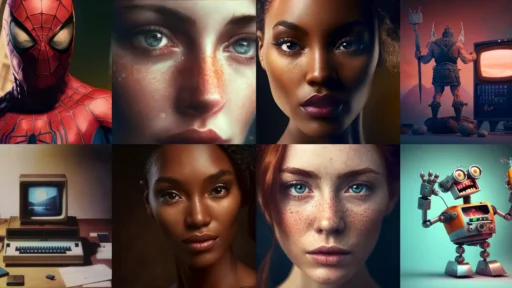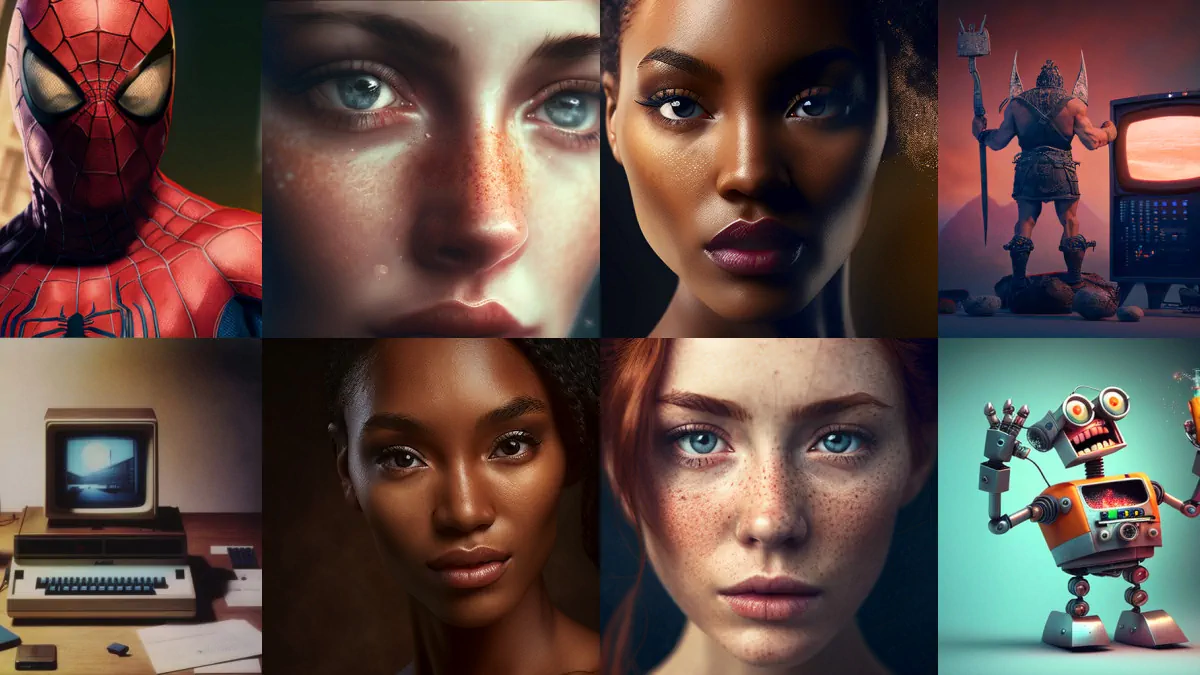If you’re into AI-generated art but skeptical about putting all your creative eggs in the MidJourney basket—you’re not alone.
Maybe it’s the price.
Maybe it’s the lack of flexibility.
Maybe you’re just done waiting for support tickets to be answered three days after your deadline.
Here’s the good news: the AI art space is exploding, and MidJourney’s no longer the only heavyweight in the ring.
From powerful open-source models to plug-and-play tools that work directly inside Photoshop, there’s a new breed of AI art generators that are faster, cheaper, and in some key ways—smarter.
We’re breaking down what’s out there, what works best for which kind of creative work, and how these tools are quietly reshaping industries from architecture to finance.
So if you’re looking to cut costs, speed up your production flow, or just want to play with pixels in smarter ways—this is for you.
The Rise Of Generative AI Art Tools And MidJourney Alternatives
Scroll back just a few years and creative professionals had two options: spend hours with pen and pad or open a dozen Adobe tabs.
Today? AI models can whip up product mockups in minutes, style-match typography to a client’s website, or generate entire visual campaigns with one prompt.
MidJourney entered that scene like a wrecking ball—its art quality blew people away, and forums filled up with surreal sci-fi landscapes and high-fidelity fantasy portraits.
It grabbed the attention fast:
– 16 million+ users
– projected $200 million in revenue by 2025
– flooded design teams across gaming, fashion, and marketing
But when something dominates like that, it also attracts copycats, challengers, and upgrades.
That’s exactly what happened.
We now have generative tools that either specialize in things MidJourney doesn’t do well—or come baked into software pros already use.
Review Of Top MidJourney Alternatives
Let’s look at the three tools making serious waves as MidJourney competitors:
| Tool | Best For | What Sets It Apart |
|---|---|---|
| DALL·E 3 | Highly specific image generation | Understands prompts better, creates scenes with objects that actually interact |
| Adobe Firefly | Professional creatives using Creative Cloud | Builds directly into Photoshop & Illustrator. Lets you style-transfer, re-edit vectors |
| Stable Diffusion 3 | Developers, technical users | Fully open-source, highly customizable for niche applications like medical or AR work |
DALL·E 3, from OpenAI, is ridiculously good at following instructions. Want a product staged in a kitchen that looks like it belongs in Morocco, with a cat in the frame? Nailed.
Adobe Firefly goes hard on integration. Designers don’t need to export to another tool—Firefly lives inside the suite they already use. Want generative fill inside Illustrator? It’s here.
Stable Diffusion 3 is the playground. If you like to build custom tools, this one’s for you. Architectural firms are using it to render sustainable designs 5x faster than traditional CAD workflows.
Competitive Analysis: Speed, Cost, And Creative Control Compared
Here’s where things get tactical—how do these tools stack up in the real world?
- Price: MidJourney charges around $30/month for decent speed. DALL·E 3 offers powerful generation in ChatGPT’s $20/month plan. Stable Diffusion? It’s free—if you can set it up.
- Speed: Firefly and DALL·E 3 load up fast because they’re cloud-optimized. MidJourney can lag during peak times. Stable Diffusion? Your hardware decides.
- Customizability: Stable Diffusion wins. With open weights, devs use it for fields like medical scans or game textures. MidJourney keeps its model closed off.
- Creative Outputs: MidJourney’s still top-tier in beauty shots—perfect lighting, symmetrical faces. Firefly is more about clean, editable layers. DALL·E 3 lands somewhere in the middle but crushes context-aware tasks.
And here’s what many folks miss: 73% of designers report saving money using AI tools like these, not by replacing staff—but by handling grunt work faster. (Design Census 2024)
Small studios that couldn’t afford multiple licenses now pay ten bucks for tools that generate billboard concepts overnight.
Even Adobe—which used to charge premium rates for niche plugins—is seeing upsells from Firefly jump 310% YoY (Q1 2025 SEC Report). That’s not just growth—it’s the market reframing itself around creator tools that double as finance savers.
So yeah, MidJourney built the stage.
But now everyone’s bringing their own instrument.
And frankly? Some of them play better.
Bridging AI Art and Financial Management: A Convergence of Innovation
AI Tools in Budgeting and Expense Tracking for Creative Industries
Creative professionals are under pressure—deadlines shrinking, budgets tightening, and client expectations climbing. So when tools like DALL·E 3, Firefly, and Stable Diffusion started showing up in financial dashboards, people asked: is this just another gimmick? Or will these Midjourney alternatives actually save us time and money?
Turns out, the shift is real. Generative AI tools are already helping creative teams replace manual spreadsheets and clumsy budgeting tools with responsive, auto-adjusting platforms. Instead of toggling between Adobe Illustrator and Excel, agencies now get live financial snapshots embedded within their design phases. And it’s not theory—Shopify store owners using AI-generated visuals are seeing 23% higher conversion rates, freeing up cash that gets reallocated toward more immersive media like AR/VR.
Stable Diffusion’s integration into prototyping systems has cut asset generation times in half, allowing teams to produce more while spending less. According to a 2025 industry survey, median design project costs dropped from $2,500 to around $800 thanks to automated templates and on-the-fly image tweaks. These AI-driven platforms aren’t just painting pictures—they’re painting line items directly into budgets.
- Time-saved: Intuit QuickBooks users say automated AI-generated infographics reduced meeting prep time by up to 35%.
- Error reduction: DALL·E 3 acts as a watchdog for receipt inconsistencies, flagging mismatches in scanned expenses with near 93% accuracy.
- Live sync: Adobe Firefly’s Creative Cloud syncs with budget tools to reflect real-time cost impacts as assets are tweaked.
This new breed of software is reframing creative project planning by syncing each pixel tweak with bottom-line shifts, meaning art directors and CFOs are finally speaking the same language.
Use Cases in Financial Reporting and Visualization
Inside JPMorgan Chase, it used to take up to five days to prepare a quarterly earnings presentation. Now, DALL·E 3 processes the same data in under an hour, converting dense spreadsheets into 3D interactive visuals that executives can present on the fly. That’s not just speed—that’s clarity.
Across the board, financial institutions are leaning on Midjourney competitors to decode data. Morgan Stanley’s Atlas platform, for example, renders entire investment portfolios as explorable 3D landscapes. It’s like GTA for wealth management—without the chaos, of course.
Ernst & Young took it further, custom-training their own AI model on decades of audit visuals, reducing manual reporting hours by over 500 each month. And these aren’t just slick charts. Financial departments now depend on generative AI to:
- Create highly digestible performance visuals for stakeholders.
- Highlight errors in transaction entries and scanned receipts using computer vision.
- Display predictive budget forecasts during live meetings with drag-friendly infographics.
This isn’t just about showing data faster—it’s about making the information stick. A colorful, AI-generated cash flow map isn’t window dressing—it’s changing how teams communicate performance internally and to investors.
AI Tools for Creative Agencies: Interaction Between Design and Finance
Ask any creative director what their biggest headache is, and you’ll hear the same story: juggling creative output with cost constraints. What’s emerging now is a middle ground, thanks to AI tools that blend creative and financial workflows into a single canvas.
Look at Adobe Firefly’s momentum: a 310% year-over-year jump in upsells tied to its financial visualization features. Why? Because it plugs directly into Photoshop and InDesign while offering real-time budgeting tools synced to QuickBooks. Creatives can now drag a logo onto a billboard mockup—and watch the campaign’s projected media spend update in real time.
Toyota’s design team is pushing the edge, using Stability AI to auto-generate thousands of car design variants based on material availability and pricing fluctuations. Every design shift adjusts the projected budget live, allowing product and finance teams to iterate together—something that was unheard of a year ago.
And startups like ArtFi are tokenizing digital artworks generated by Midjourney alternatives into NFT-backed portfolios with blockchain-tracked valuation—blurring lines between creative assets and investment instruments.
Dual-purpose tech is no longer theoretical. Designers now operate inside interfaces where design changes echo directly in cost breakdowns, and stakeholder reviews come with budget warnings or green lights baked into the preview.
Investment Platforms and Industry Trends Related to AI Art
Investment Trends in Creative AI Technologies
Venture capitalists aren’t guessing—they’re betting big. The fusion of AI art tools with financial platforms has soaked up over $7.3 billion in funding since early 2023. Companies like Brixyn are pulling in $14.7 million seed rounds for AI systems that function as both a creative assistant and digital bookkeeper.
This isn’t just quantity—it’s quality. NVIDIA’s 170% funding surge into Omniverse came right after they rolled out real-time AI texture rendering merged with immersive financial simulations. Investors are clearly hunting for companies that blend storytelling with spreadsheets—platforms where art meets automation.
Why the stampede? Public firms using generative AI for both creative and operational needs outperformed the S&P 500 by 18% last year. It’s not hype when returns are backed by accelerated prototyping, reduced waste, and faster go-to-market timelines.
Risks and Challenges in the Convergence of Creative AI and Finance
Still, it’s not all upside. Legal headaches are mounting—2024 alone saw $230 million spent on copyright litigation linked to AI-generated visuals used in finance reports. Many of these tools remix visual patterns without attribution, opening companies to IP landmines.
Accuracy is also under the spotlight. MIT’s analysis showed a 15% variance between AI-generated financial projections and those created by traditional analysts. For companies making million-dollar decisions based on those charts, that margin isn’t just noise—it’s risk.
There’s also the hallucination problem. A full 34% of CFOs flagged AI-generated visuals as misleading or overconfident—especially in quarterly earnings snapshots. In financial storytelling, confidence without context can cost more than bad data.
Predictions for Market Growth
Industry analysts aren’t hedging: companies that combine generative AI with financial operations are expected to grow at double the rate of their single-domain counterparts through 2028.
Partnerships are forming faster than compliance frameworks can keep up. Adobe, for example, is layering financial analytics atop its design suite. Meanwhile, Intuit is developing plug-ins that let creatives toggle between invoice breakdowns and AI-generated mockups mid-project.
This hybrid zone—where visual and financial clarity meet—is becoming the new normal. Expect to see more dual-use dashboards, fewer walls between departments, and a rise in tools built not for coders or creatives—but for both, simultaneously.
Strategic Insights for Developers, Investors, and Agencies Adapting in the AI Era
Let’s be real—AI is no longer a side project. It’s core. It’s reshaping how we design, how we balance the books, and how we build sustainable businesses. If you’re a developer trying to launch faster, an investor hunting for real traction, or an agency fighting margin creep—this is your lane. Midjourney alternatives aren’t visual gimmicks anymore. They’re infrastructure.
Best Practices for Developers
The developers winning right now are the ones treating AI tools like infrastructure—not bells and whistles. If you’re still hardwiring outputs into rigid interfaces, you’re burning time.
- Build API-first. This isn’t optional. If your AI visuals can’t plug straight into accounting tools, ad platforms, or CRMs, clients will bounce.
- Go open-source where it counts. Stable Diffusion 3 is flexible enough to be molded into whatever vertical you’re tackling—architecture, e-commerce, or fintech UI.
Build modular, not monumental. Train on lean datasets, ship fast, integrate deep. Freemium models like DALL·E 3’s $20/month tier prove that scale comes from access, not tech elitism.
Investment Opportunities for VCs and Tech Entrepreneurs
Hybrid AI startups are outperforming single-domain plays by a long shot. Why? Because they short the cycle from insight to execution. A generative AI that visualizes reports while autonomously correcting budget overspend? That’s traction. Not theory. We’re talking $7.3B in VC flow since 2023 for dual-use tools.
Hot flash: platforms like Brixyn are blending creative production with bookkeeping automation—and closing seed rounds 22% higher than their siloed peers. Want ROI? Focus on startups that:
- Marry GANs with predictive analytics
- Handle both user emotion and enterprise reporting
And yes, keep one eye on ecosystem players like NVIDIA stacking returns by fusing AI art with financial simulation engines. This wave isn’t just visual—it’s visual logic plus fiscal control.
Navigating Challenges for Creative Agencies and Enterprises
Midjourney alternatives cut design costs from $2,500 to $800. Those aren’t theoretical savings. That’s real cash you can reallocate. Agencies are funneling cuts into AR/VR. Why? Immersive branding = higher lifetime value, especially in D2C.
But don’t get reckless. Patents, copyright, and compliance still own the sandbox. $230M in lawsuits in 2024 proves creative-finance overlap is becoming a courtroom favorite. If you use AI visuals, lock down IP legal frameworks just like you’d insure a physical factory. Creative assets are financial assets now. Treat them like such.
Future of AI Art Generators: Insights into a Transformative Industry
If you think Midjourney alternatives are just about pretty pictures, you’re missing the entire point. These tools are the gateway drug to real-time financial strategy, faster product loops, and breaking the old-school notion that “art is soft.” The creative pipeline is now tied directly to business ops—and the shift is permanent.
Emerging AI-Financial Synergies
Imagine this: You’re designing a sneaker. Your AI tool scans fluctuating rubber prices, then repositions your paneling and midsole height… in real time… to hit margin targets. That’s live design-to-cost optimization—and it’s already prototyped.
Want next level? Startups like ArtFi are collateralizing AI art into NFT-backed financial portfolios. Fully trackable. Blockchain-verified. You’re not just selling creativity anymore; you’re building liquidable capital structures from it.
Regulators aren’t sleeping either. The EU’s coming AI Act has early-stage platforms using Stable Diffusion to visualize compliance consequences. Not read them—see them. Layers rendered like MRI slices of legal vulnerability.
Long-Term Impacts of AI Art on Financial Management
AI-generated art isn’t just something you slap into a brandbook. It’s becoming a core driver of visualized finance.
Morgan Stanley’s Atlas platform already renders portfolio data into navigable 3D landscapes. Ernst & Young cut 500+ monthly hours from audit work just by using AI-generated visuals. That’s not convenience—it’s compounding.
The real kicker? It’s starting to feel like art and finance are finally holding hands. The same tool rendering your product mockups is interpreting your quarterly reports. These interlinked systems are building a moment where analysts and designers are using the same software suite. It’s the crossover episode of business tech no one saw coming.
Inspiring a Sustainable, AI-driven Future
This all sounds flashy, but if you don’t ground AI gen-tools in sustainability, you’re just scaling burnout. Training models that suck city-sized water supplies only make sense if you’re also deploying those models to cut waste.
The new age isn’t about innovation for flex. It’s about building global access. Emerging markets can now generate studio-grade branding, visualize cashflow, and self-manage bookkept operations with one open-source stack. That used to take whole teams and years of capital. Now, it’s an hour and a free-tier generative engine.
Midjourney alternatives are not just tools. They are economic multipliers. The future is frictionless creation tied to financial clarity—and accessible in every internet-connected zip code.






